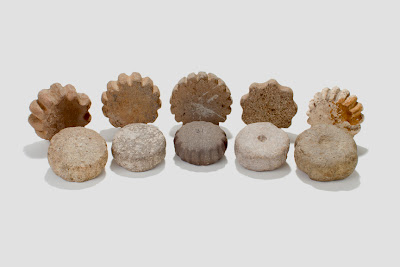Cog Stones, suggested date 6000-3500 B.C.
Milling Stone Horizon Peoples; Southern California
Various stones including basalt; average dimension: 3.75 x 1.5 in.
Gifts of Chas M. Decker, Mary J. Newland and Hirim Whisler
478, 536, 11669, 3649, 477
Known as cog stones or cogged stones, these archaeological materials have been found throughout the Southern California area with large deposits found along the Santa Ana River valley. Cog stones are named so because of their indentations that give them the appearance much like that of a cogwheel. Some cog stones are pierced through the center and others have flat surfaces. Four separate styles have been identified based on perforation and groove depth and length. Cog stones are remarkable in that they are found nowhere else in the world and archaeologists and scholars are unsure what their exact function was. The stones’ enigmatic status has led researchers to develop several theories of their purpose, including that the objects served a ritual purpose. Usually found on ocean bluffs or other coastal hilly areas, the stones are attributed to the ancient and non-nomadic people of the Milling Stone Horizon culture.
All images and text under copyright. Please contact Collection Department for permission to use. Information subject to change with further research.


Comments 5
I recently visited two museums in Peru. There are many metal and stone relics very similar to the OC cogstones at the Museo de Oro at Lima. It is fairly clear that they were used in Peru as a club head. Most have a hole at the center. While the cogs stones in OC often do not have a center hole, they would make an effective club or hammer since an adult hand and fingers fit very well in the "cogs".
The cogged stones pictured may have served as anchor stones for coastal fishing nets used by the Indians of the area. A northern example of something like this is shown in pictures in a book:Indian Fishing: Early Methods on the Northwest Coast by Hilary Stewart. (scroll up or down to see illustrations)This is not definitive proof, but it may have been one application, especially for those with a hole in them.
The cogged stones may have been 'anchor' stones for coastal fishing nets. An example of this can be found in book: "Indian Fishing: Early Methods on the Northwest Coast" By Hilary Stewart (scroll up & down for pix)http://books.google.com/books?id=fudyXm4KMpQC&lpg=PA79&ots=m-LR8MHjSk&dq=indian%20fishing%20nets&pg=PA87#v=onepage&q=indian%20fishing%20nets&f=trueThis is not a definitive proof, but it may offer a clue as to the cog stones' original purpose. Some of the cog stones have holes in them, but others not.
Hi ~ I found what looks like a primitive cog stone. Can I send you a picture?
many groups of 1st peoples in the
America’s worshiped the sun as did
the 1st peoples of Southern California.
I believe these stones are in fact charm stones and represent the sun. The same
basic form or design is found in many
basketry trays and shallow bowls made
by all the different SoCal tribes.